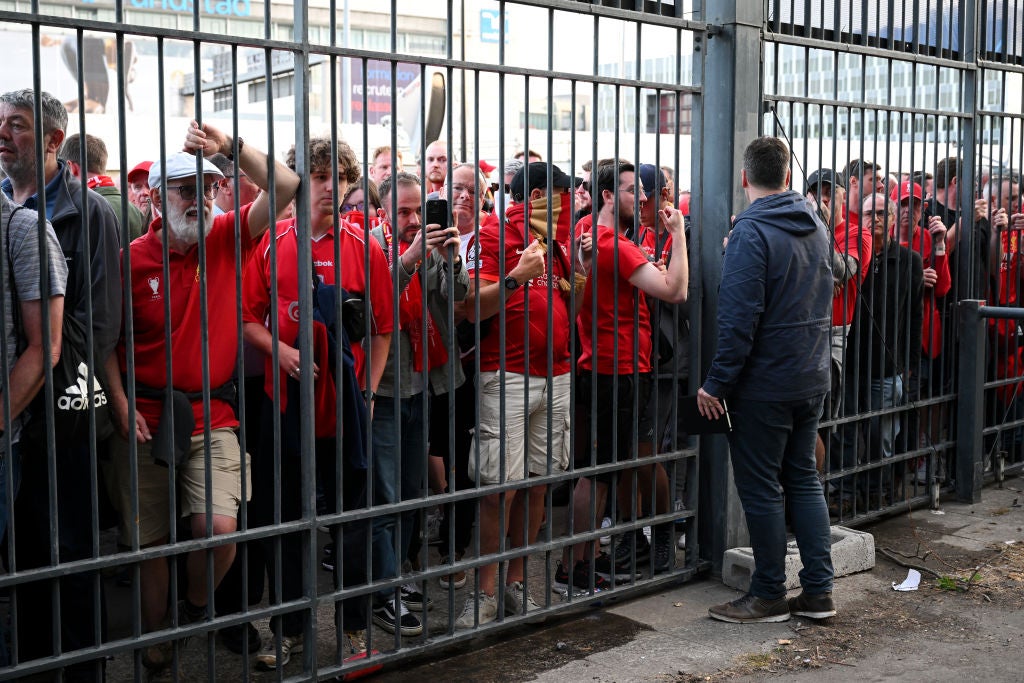What led to the chaotic scenes at Champions League final?
The match between Liverpool and Real Madrid took place at the Stade de France on May 28

Your support helps us to tell the story
From reproductive rights to climate change to Big Tech, The Independent is on the ground when the story is developing. Whether it's investigating the financials of Elon Musk's pro-Trump PAC or producing our latest documentary, 'The A Word', which shines a light on the American women fighting for reproductive rights, we know how important it is to parse out the facts from the messaging.
At such a critical moment in US history, we need reporters on the ground. Your donation allows us to keep sending journalists to speak to both sides of the story.
The Independent is trusted by Americans across the entire political spectrum. And unlike many other quality news outlets, we choose not to lock Americans out of our reporting and analysis with paywalls. We believe quality journalism should be available to everyone, paid for by those who can afford it.
Your support makes all the difference.The long-awaited independent report into the chaos at the Champions League final between Liverpool and Real Madrid in Paris has been published.
Here is a look at some of the factors which contributed to disorganised and worrying scenes at the Stade de France.
Logistics
A rail strike meant only one of the two railway lines to the stadium was fully operational, resulting in thousands of Liverpool fans travelling from the city centre all arriving at the same Stade de France Saint-Denis station. The 15-minute walking route to the stadium was not signposted and fans were directed into a built-up area and through a narrow subway and motorway underpass – partially blocked by strategically-placed police vans – to a checkpoint at the foot of a 30-foot wide ramp which was not designated as a main entrance.
Ticket checks
The amount of time to check tickets – complicated by issuing a mix of paper and digital tickets – resulted in huge congestion building up at checkpoints with an estimated 15,000 fans congested in that area more than two-and-a-half hours before kick-off. The French Senate report into the final accepted a “risk of crushing” did develop – particularly traumatic for Liverpool fans, specifically Hillsborough survivors – and ticket pre-checks were abandoned.
Violent attacks
Abandoning ticket checks allowed a number of local youths to access the perimeter of the stadium. A number of those either attempted – and some succeeded – to jump the fence or tried to steal tickets from fans penned in as the turnstiles had been closed. The Senate report estimated 300-400 locals committed “numerous acts of theft with violence observed by the police”. After the match local gangs ambushed fans exiting the stadium and with no police protection numerous were subjected to violent robberies by thugs with weapons.
Police response
Having allowed congestion to build up to dangerous levels outside the perimeter, the police’s response was to indiscriminately pepper spray fans – including children – pressed up against the railings in an attempt to relieve pressure on the turnstiles. As the match drew to a close police in riot gear emerged inside the stadium and proceeded to position themselves around the Liverpool – but not Madrid’s – end. However, a lack of presence outside the stadium contributed to gangs running riot against defenceless supporters outside.
UEFA’s actions
Kick-off was delayed initially for 15 minutes, eventually for 36 minutes, with an initial message displayed on screens inside incorrectly blaming Liverpool fans’ late arrival which prompted outrage from Reds supporters already inside. UEFA doubled-down on the blame after the match, issuing a statement relayed to broadcasters which said: “The turnstiles at the Liverpool end became blocked by thousands of fans who had purchased fake tickets which did not work in the turnstiles”.
Local authority intervention
French ministers had talked of Liverpool supporters as having been a major hooligan threat, contrary to the Merseyside Police intelligence, and it emerged police had acted on a misconceived view of the Hillsborough disaster and believed it meant they had to have riot police in force. French interior minister, Gerald Darmanin, claimed “30,000 to 40,000 Liverpool fans” had forged or no tickets, alleging there had been an “industrial scale” ticket fraud. However, the Senate report stressed it was “unfair to have tried to blame the Liverpool supporters for the disturbances to divert attention from the state’s inability to adequately manage the crowds and to curb the actions of several hundred violent and co-ordinated delinquents”.

Join our commenting forum
Join thought-provoking conversations, follow other Independent readers and see their replies
Comments